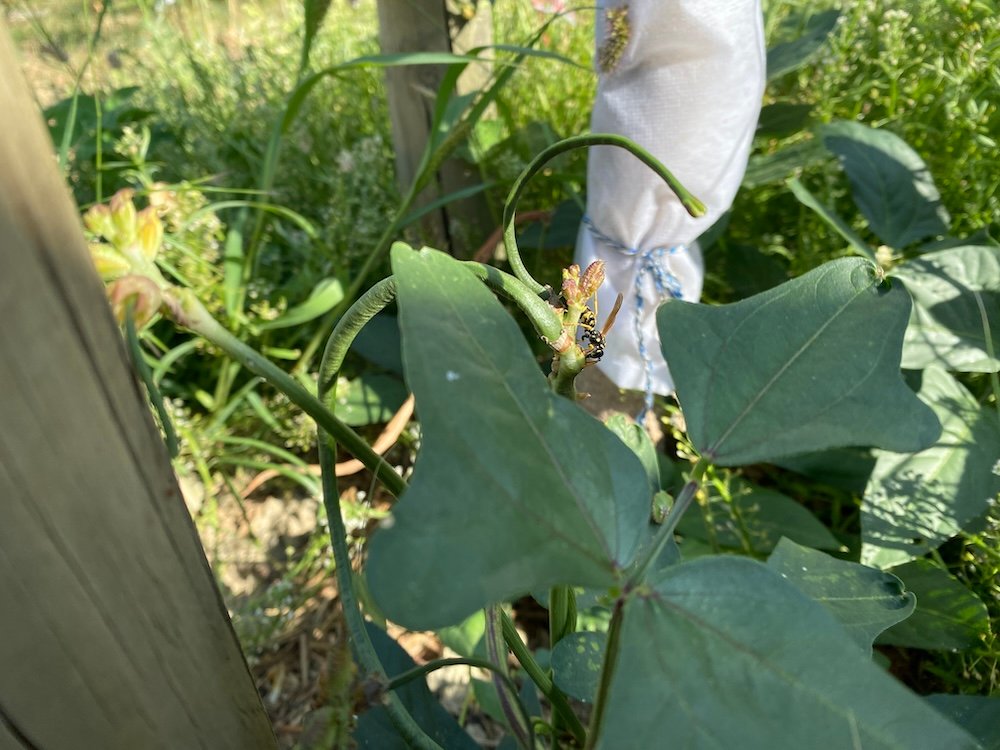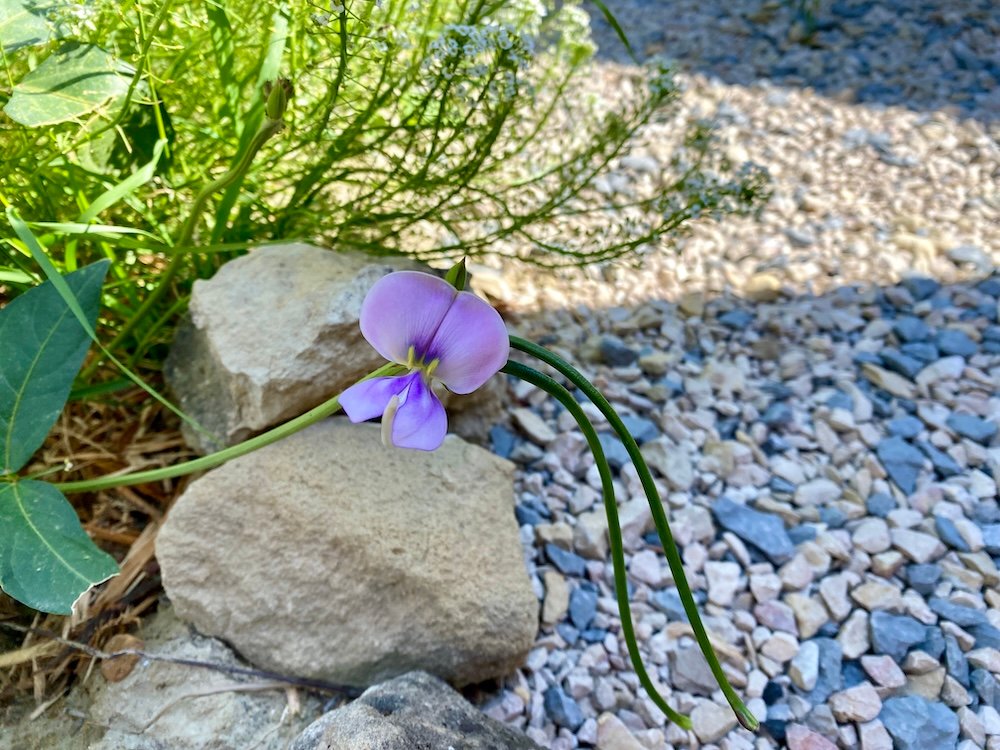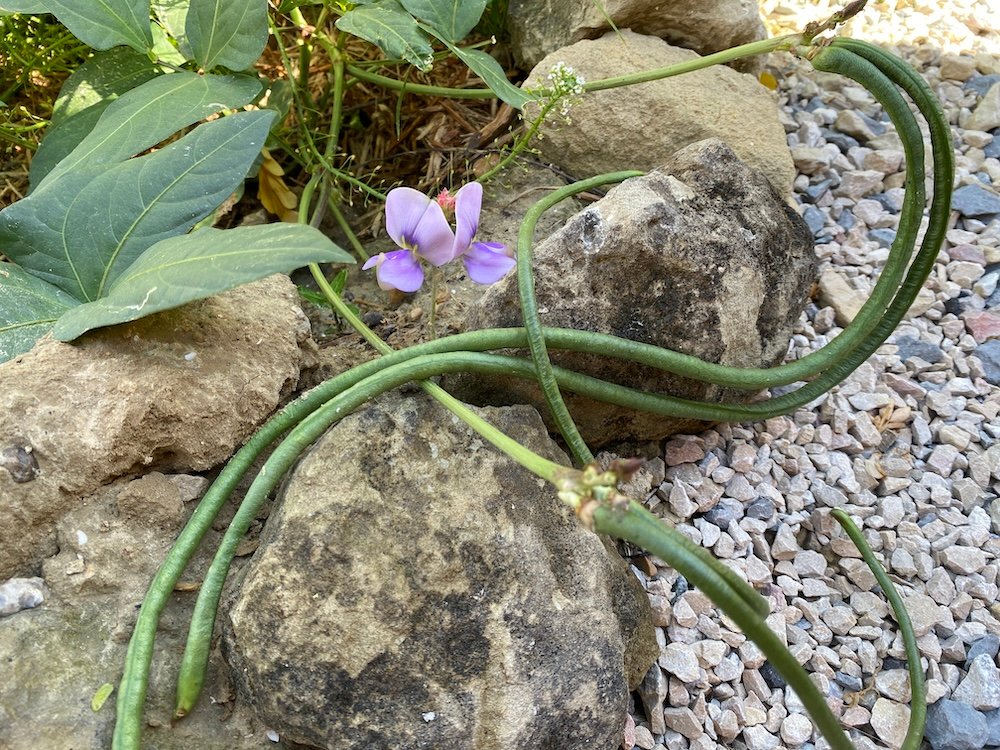It took three summers to determine which kind of beans or peas will really work for us in this mediterranean garden.
What works for me:
Asparagus Beans / Vigna unguiculata sesquipedalis
A definite keeper! From early July through late September I can harvest handfuls of long green, tasty and tender beans. They are also popular with ants and wasps who love the sweet sap at the base of the pods. Apparently these beans can grow up to three meters long, mine have grown up to 60 cm long. I usually take them as soon as feasible as pods that hang too long can have a tendency to get soft and bumpy with ripening seeds. They also do not need any fertilizer or additional water but a bit or watering now and then does not hurt either.
As the Latin name implies this is also a type of cowpea-bean, coming from Asia. Its subname sesquipedalis means “foot and a half long” and refers to the unusually long pods.
These beans can be eaten raw or cooked. They easily become waterlogged and should not be boiled too long but blanched quickly, sautéed or fried. Freezing is not a good idea as they will get tough. I usually harvest beans every morning before they grow too thick and become soft and leathery. They keep well, rolled into a wet paper towel, in the vegetable drawer of the fridge.
And did I say they have gorgeous purple flowers? They do!



Sugar Snap Peas
Another keeper for winter cultivation. I tried these last winter as an alternative to regular garden peas. They grew very well over the winter and started blooming in February. The harvest began slowly in March but accelerated quickly. Until the end of April I had to pick peas every two days to keep the pods from getting too big and stringy. Finally lots of wonderful sweet peas to eat.
What works generally – but isn’t “my thing”:
Broad Beans / Vicia faba
Broad Beans at first seemed a really good idea. Especially because they can be planted over the winter when the dreaded black aphids aren’t around. I planted them for two years running and though they grew well and had lots of pretty black and white flowers, they never really produced that many pods. Plus the disparity between the amount of pods, the work involved in shelling and peeling, and the final amount of edible beans makes no sense for me and I’ve decided against planting them again.
Tepari Blue Speck / Phaseolus acutifolius
Another Seedshunters dry-farming bean from Arizona. The Tepari bean plants grew well but stayed small despite shading and watering, producing very small and stringy pods with very hard seeds. Again not worth the effort to me, not having a large space to dedicate to drying beans.
Anellino Dwarf Bean / Phaseolus vulgaris
A Seedshunters dry-farming bean from Italy. The plants grew well and produced pretty curled-up green and purple bean pods. However the seeds grew hard very quickly in summer and just for them it’s not worth the effort if one does not grow a whole field full of them.
Bisbee Red Beans – Vigna unguiculata
Bisbee Red Beans are a kind of “cowpea”-bean. The seeds are quite hard to find in Europe. I ordered them from the “dry farming” section of seedshunters.com, who in turn got them from a Germplasm bank of native seeds of indigenous Amerindians of the desert and semi-desert areas in the US South West.
I have grown them this summer for the first time. The plants are very robust and undemanding, growing vigorously even without ANY additional watering. They climb a bit or creep along the ground but do not grow overly long. The blooms and pods take quite some time to appear and the plants are not overly productive so far. The pods can be eaten whole when very young, but they ripen rather fast and turn stringy and bumpy with the dark red seeds inside. Again, not worth the effort to me.
Garden Peas
Since I love fresh peas I tried the local variety “Petit pois nain provencal”. They grew well and produced a nice amount of pods in spring but these grew stringy quickly. And the amount of pods compared to the final small amount of edible peas is just disproportionate to me. I gave the rest of the seeds away and decided to focus on sugar snap peas.
What didn’t work at all:
Runner Beans / Phaseolus coccineus
Scarlet Runner Beans are called “Firebeans” in German and “Haricots d’Espagne” in French. Which led me to believe that they were perfect for mediterranean climates. I could not have been more wrong. This bean comes from South America and it is special – but for tolerating cold better than normal green beans, not heat. They do grow here and they do get lots of lovely flowers, but they simply will not set pods in the summer heat. In Greece, as well as Turkey and North Africa they are cultivated in winter but since they do not tolerate frost at all that wouldn’t work here either.
I’ve tried various varieties of runner beans, including a very recommended variety called “Orteil du Precheur” (“preacher’s toe”) – none of them produced a single edible bean.
It goes without saying that regular green beans (phaseolus vulgaris), whether the bush or pole variety, also are not heat or drought tolerant. If planted very early in spring you may get some pods but as soon as the heat sets in they shrivel up.
Bush Beans for Fall cultivation?
I am currently experimenting with grown Bush Beans “Contender” in the fall, sowing them in July. Stay tuned.

Leave a Reply